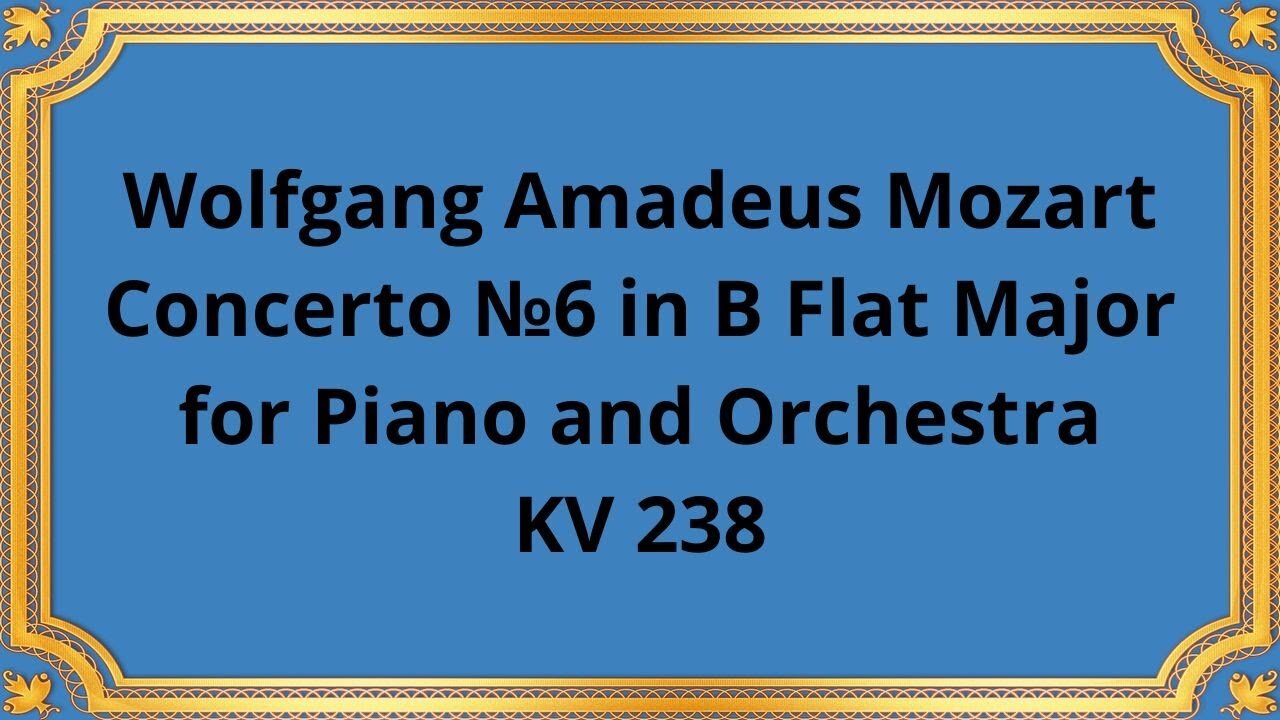Premium Only Content

Wolfgang Amadeus Mozart Concerto №6 in B Flat Major for Piano and Orchestra KV 238
#Mozart #ConcertoNo6 #BFlatMajor #PianoAndOrchestra #KV238 #ClassicalMusic #MusicalComposition #ClassicalConcerto #WolfgangAmadeusMozart
Publication date 1956
HANS HENKEMANS, Piano
Bernhard Paumgartner conducting the Vienna Symphony Orchestra
Wolfgang Amadeus Mozart, a prodigious composer of the Classical era, left an indelible mark on the world of music. Among his vast repertoire, Concerto No. 6 in B Flat Major for Piano and Orchestra KV 238 stands as a testament to his genius.
Mozart composed Concerto No. 6 in B Flat Major in 1776 when he was just 20 years old. This period marked a significant phase in Mozart's life, as he had recently moved to Vienna, a city teeming with musical vibrancy and opportunities. It was during this time that Mozart's compositions began to showcase his unique style and mature artistic voice.
The concerto is composed in the standard three-movement structure commonly found in classical concertos. The first movement, marked Allegro aperto, introduces the thematic material with a lively and energetic character. The second movement, marked Andante un poco adagio, unfolds with a serene and expressive melody, providing a moment of reflection. The final movement, marked Rondeau: Allegro, brings the concerto to a breathtaking conclusion with its vibrant and spirited tempo.
Mozart's Concerto No. 6 is scored for piano and orchestra, showcasing his skillful handling of both solo and tutti sections. The orchestra provides a rich tapestry of accompanying harmonies and counterpoint, while the piano takes center stage, engaging in a captivating dialogue with the orchestra.
The concerto exhibits Mozart's trademark melodic inventiveness. In the first movement, the piano introduces a lively and spirited theme, which is then developed and expanded upon by the orchestra. The second movement presents a beautifully lyrical melody, evoking a sense of poignancy and introspection. The final movement bursts with exuberance, featuring catchy and virtuosic passages that showcase Mozart's technical prowess.
Concerto No. 6 in B Flat Major displays Mozart's remarkable ability to blend technical brilliance with expressive depth. It exemplifies his mastery of musical form, harmonic progression, and thematic development. The concerto also showcases Mozart's unique ability to balance the roles of soloist and orchestra, creating a harmonious interplay between the two.
Conclusion:
Mozart's Concerto No. 6 in B Flat Major for Piano and Orchestra KV 238 is a masterpiece that epitomizes the composer's genius and his contribution to the classical music repertoire. Its historical significance, structural complexity, and melodic beauty make it a captivating work for both performers and listeners alike. Through this concerto, Mozart continues to inspire and enchant generations, leaving an enduring legacy in the world of music.
You have the opportunity to support the channel:
https://destream.net/live/RadSiarAl/donate
https://www.buymeacoffee.com/6355radsiaral
-
 24:35
24:35
Classical music_Music Inspiration
10 days agoMax Bruch Violin Concerto No. 1 in G minor, Op. 26
831 -
 40:45
40:45
Donald Trump Jr.
5 hours agoPeace by Peace: Solving One Problem After Another | Triggered Ep.268
39.9K50 -
 LIVE
LIVE
FrizzleMcDizzle
2 hours agoRemnant 2 - Dark Souls-like Shooter?!
99 watching -
 LIVE
LIVE
FoeDubb
1 hour ago🏰KINGDOM MENU: 🏈FOOSBALL & 🎮DELTA FORCE PEW PEWS DILLY DILLY!!
21 watching -
 11:43:31
11:43:31
GritsGG
12 hours agoWin Streaking! Most Wins 3390+ 🧠
53.3K -
 1:08:29
1:08:29
TheCrucible
5 hours agoThe Extravaganza! Ep. 24 (8/19/25)
72.9K15 -
 4:22:25
4:22:25
sophiesnazz
6 hours ago $0.55 earnedLETS TALK ABOUT BO7 !socials !specs
19.1K -
 1:27:30
1:27:30
Redacted News
5 hours ago"There will be consequences!!!" Trump issues big threat to Putin ahead of peace summit | Redacted
97.8K161 -
 LIVE
LIVE
Amish Zaku
3 hours agoWar Thunder - Tank Tuesday - then Peak
64 watching -
 1:27:05
1:27:05
Kim Iversen
5 hours agoIsrael DEMANDS X Remove Posts and X COMPLIES | Socialist Groceries Coming To A Store Near You!
49.9K122